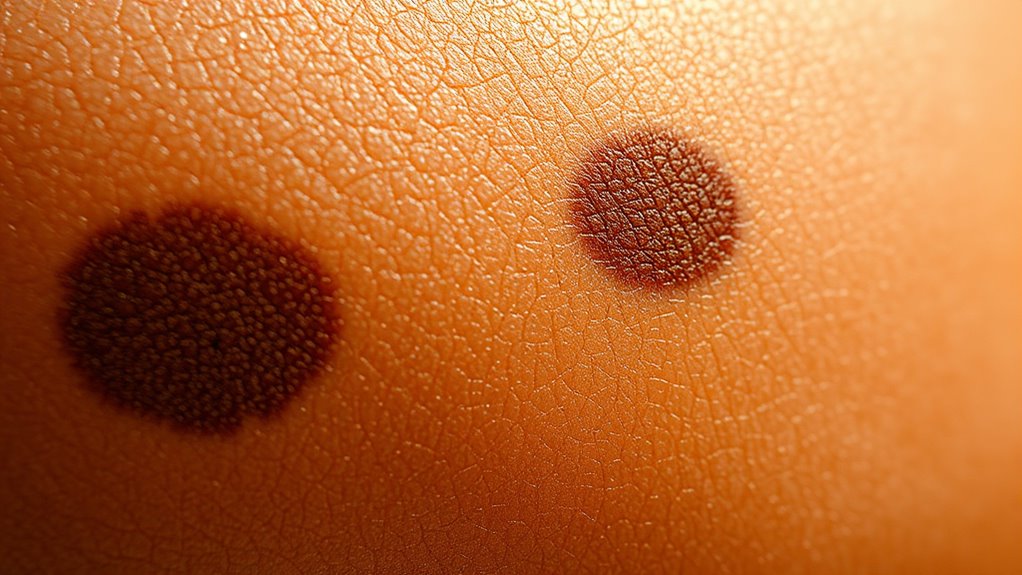When your skin tans, it’s your body’s way of protecting itself from UV rays. Exposure to sunlight activates the production of melanin, the pigment that gives your skin its color. This process involves enzymes converting amino acids like tyrosine into melanin, which then darkens your skin as a shield against UV damage. Understanding how melanin works helps you see why sun protection is important—and there’s much more to uncover about how your skin responds to the sun.
Key Takeaways
- Melanin is produced in response to UV exposure, acting as a natural sunscreen for the skin.
- UV rays activate the enzyme tyrosinase, which converts tyrosine into melanin.
- Melanin is stored in melanosomes and transported to skin cell surfaces, darkening skin tone.
- The amount and type of melanin determine how dark or light your skin appears.
- Increased melanin production results in tanning, providing temporary protection against UV damage.

Melanin is a natural pigment responsible for giving color to your skin, hair, and eyes. When you spend time outdoors, especially in the sun, your body responds by producing more melanin. This process, called melanin synthesis, is your skin’s way of protecting itself from damage caused by UV radiation. As UV rays penetrate your skin, they trigger a series of reactions within specialized cells called melanocytes. These cells respond by increasing melanin production, which then gets distributed to surrounding skin cells, darkening your skin and creating a tan.
Melanin production increases outdoors, darkening skin and providing natural UV protection.
UV radiation is a major factor in this process. When your skin absorbs UV rays, it can cause cellular damage, leading to premature aging and increasing the risk of skin cancer. To combat this, your body ramps up melanin synthesis as a natural defense mechanism. Melanin acts like a shield, absorbing and dispersing UV radiation before it can harm the DNA within your skin cells. The more UV exposure you experience, the more melanin your body produces, resulting in a darker skin tone. That’s why your skin tends to tan after prolonged sun exposure—the increased melanin helps reduce further damage and provides a temporary layer of protection.
The process of melanin synthesis begins when UV radiation interacts with a molecule called tyrosine, an amino acid present in your skin. This interaction activates an enzyme called tyrosinase, which catalyzes the conversion of tyrosine into melanin. From there, melanin gets packaged into tiny structures called melanosomes, which are then transported to the surface of your skin cells. Once at the surface, the melanosomes release melanin into surrounding cells, darkening your skin and creating that sun-kissed glow. The amount and type of melanin produced determine your skin tone—whether you have lighter, darker, or somewhere in between.
Your skin’s response to UV radiation isn’t just about tanning; it’s a complex protective mechanism that involves genetic factors, environmental exposure, and your overall health. Some people produce more melanin naturally, which helps explain why skin tones vary widely across populations. Others might tan more easily or have a higher resistance to UV damage. Understanding how melanin synthesis works can help you appreciate your skin’s resilience and the importance of protecting it from excessive UV exposure. Wearing sunscreen, seeking shade, and avoiding peak sun hours are practical ways to support your skin’s natural defenses while still enjoying the sun responsibly. Additionally, advances in cybersecurity vulnerabilities during system outages highlight the importance of maintaining secure technological environments, just as skin protection is vital for health.
Frequently Asked Questions
Does Melanin Affect Skin Aging or Wrinkle Formation?
Melanin plays a role in skin aging and wrinkle formation by influencing how your skin responds to UV exposure. Higher melanin levels can offer some protection, helping maintain skin elasticity and reducing early signs of aging. However, prolonged UV exposure still damages collagen and accelerates wrinkles. So, while melanin helps shield your skin, consistent sun protection is essential to keep your skin youthful and healthy over time.
Can Melanin Production Be Increased Naturally?
You can naturally boost melanin production by focusing on dietary influences and natural remedies. Eating foods rich in antioxidants, vitamins A, C, and E, like carrots, berries, and nuts, supports melanin synthesis. Sun exposure in moderation can also stimulate production, but always protect your skin. Incorporate natural remedies like herbal supplements or oils known for skin health to enhance melanin levels safely and effectively.
How Does Melanin Influence Skin Cancer Risk?
You should know that melanin influences your skin cancer risk by providing some natural protection against UV damage. However, your genetic predisposition and environmental factors, like sun exposure, play significant roles. If you have less melanin, you’re more vulnerable to UV rays, increasing your risk. Protecting your skin with sunscreen and avoiding excessive sun exposure can help reduce the chances of developing skin cancer, regardless of your melanin levels.
Are There Different Types of Melanin in the Skin?
Oh, the irony is you might think there’s just one kind of melanin, but your skin actually hosts different types. Thanks to genetic variation, your body determines how much and what kind of melanin to produce through melanin synthesis. Eumelanin gives you those rich browns and blacks, while pheomelanin provides reds and yellows. So, yes, your skin’s melanin isn’t just one, but a mix tailored by your genetics.
What Role Does Melanin Play in Skin’s UV Protection?
Melanin plays a vital role in your skin’s UV protection by absorbing harmful UV rays through UV absorption. This process helps prevent damage to your skin cells. Skin pigmentation, which is influenced by melanin levels, varies among individuals and provides a natural barrier. When you’re exposed to sunlight, your skin produces more melanin, enhancing UV absorption and offering better protection against UV damage, including sunburn and skin cancer.
Conclusion
So, it’s a little surprising how your skin’s response to sunlight is both a science and a coincidence. That tiny burst of melanin protects you, almost by chance, from the sun’s harsh rays. Next time you see your tan deepen, remember it’s a perfect blend of biology and luck working together. Maybe, in some way, your skin’s natural reaction is a quiet reminder of how beautifully unpredictable life can be.









